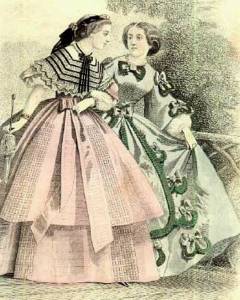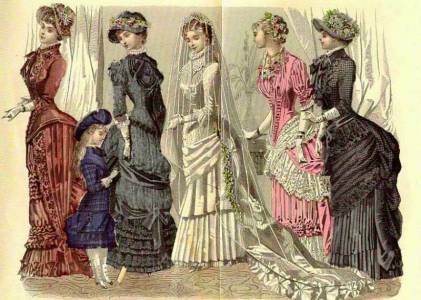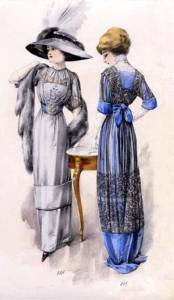The Big Time of Corsets - The 19th Century
Napoleon had his Waterloo and France had its aristocracy come back. Was that an advantage for the french people? Well, it was doubtless an advantage for the corset-makers. "Back to the good old times" was the slogan.

Corsets in this time were laced down to the waist only, because below the waist, petticoats or hoop-skirts (called crinolines in these times) defined the silhouette. These crinolines had, like in Rococo, tremendous circumferences. Until the middle of the century not only the waist, but also the lower chest were laced tight. The corsets had a shape we would call "stem waist" now, and elaborate bust-cups. New front closing mechanisms were developed, but up to 1845 they were an exception.

Very tight-laced corsets belonged to the festival- and evening-fashion of "high" society, which now included the rich citizens too. And of course, there were fashion-conscious ladies, who always and everywhere wanted to look perfect and therefore tight-laced even in their day costumes.
After the "stemwaist"-period (from middle of the century), the corsets became shorter in the waist. The "hour-glass"-silhouette was born, nowadays known as the Classic- (or Victorian-) corset-style. The corset became actually a bit more comfortable by that. However, it was possible to lace them more tightly than before, and in that case the improved comfort was lost very soon. Between 1860 and 1870, crinolines run out of fashion and were replaced by the ("cul de Paris").The corsets were longer now - and even tighter, because the optical effect of the crinoline did not exist anymore. From 1880 skirts became extremely tight, so shaping of the hips became more and more important, which was achieved with very long corsets.

With the change of the century, straight-front corsets became fashionable again (we had this before, didn't we?). They should improve comfort of wearing by decreasing pressure on the stomach area.
Even Gentlemen's fashion was not without corsets. After the dandies, especially army-officers detected the corset as a means to have a dignified, stiff bearing when wearing a uniform. These corsets had not been designed for waist reduction, if it wasn't to flatten a (beer-) belly.
Two World Wars and New Ideologies - The 20th Century

Afterwards, a very small and straight silhouette came in vogue. Corsets continued to be used, but the design became very different to the "classic" style. Now mainly the hips, the bottom and the thighs (yes, really) were corsetted. In this time, the fashion of the 'hobble-skirts', which were very tight at the lower legs, occured, but had only a short life-time.
World War I (1914-1918) finished the big time of the corset, even if the described hip-corsets were still in use until the "roaring 20th". What were the reasons for the decline? Sometimes the 'reform-dresses' are mentioned, wide and very convenient dresses, worn without corsets. They were introduced around the turn of the century and should benefit health. But these dresses were worn by a minority only, and never at important events or other more or less official occasions. They were mostly a casual dress for sports in the open air. Also various warnings about corsets because of assumed health hazards couldn't have been the true reason for the virtual disappearance of corsets. Similar warnings had been given since the Baroque age, but without a considerable effect on corset wearing. The reasons are more complex.

But the idea of emancipation, which spread in the Sixties caused corsets to become taboo. It was now regarded as a symbol for the oppression of women, exactly the same as it had been a symbol for rich and mighty women and a symbol for honourable women. From then on, corsets could only be seen with show-stars, in theaters, as sexy underwear for fetishists and (in the lacquer and leather version) in the red-light-districts or at SM-Parties.
Not until the 80's, did an increasing number of friends and enthusiasts of this garment ( who had always existed) get together. The last corset-makers (mostly located in England) passed on their knowledge to successors, as far as possible, and a small but growing market for corsets of high quality developed. Today there is a greater variety of corsets than ever before. We have an extented range of materials now, and corset styles are produced which wouldn't have been useful in former times. For instance, the under-bust corset is such a recent style (because bras are available now). All the historic corset-styles are sources for the ideas of present corset designers.
The Beginning of a new Millennium - The 21th Century
Times are over when it was a lady's duty to wear a corset, and that's all right. But times are not over when a big part of the "normal" society ostracizes corsets. Nevertheless, it isn't as bad as 20 years ago. Then, a woman had to be very courageous to wear a tight-laced corset in public. Today, it's sufficient if she has a good deal of self-confidence. Corsets even found their way again to the catwalks of the "Haute Couture" in Paris, Rome or New York (status: 2002).
The corset has already symbolized so many things. Maybe in the 21th century it will be a symbol for individualism and finding pleasure {at}in beauty, female beauty in particular.



